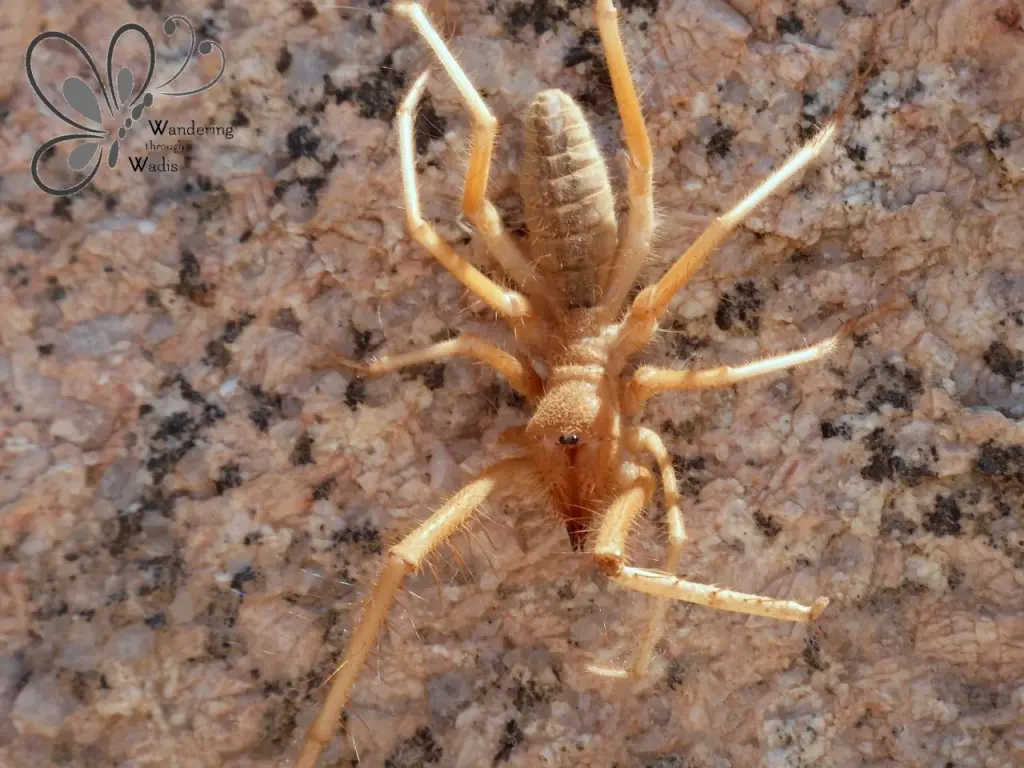Camel spiders, sun spiders, barrel spiders, wind scorpions – all of these common names for Galeodes arabs are misleading as these fascinating critters are neither spiders nor scorpions but rather solpugids, a group of arachnids in the order Solifugae. More appropriately, they are also commonly known as Egyptian Giant Solpugids.

You may have heard of them; camel spiders have been the subject of many urban legends about their size, speed, and appetite. Despite knowing that they posed no threat to me – they are not venomous but can inflict a painful bite – seeing my first one last weekend in Wadi Kid still kind of creeped me out, partly because it was as big as my hand!

Camel spiders can grow up to 15 cm long. They have eight legs, as do most arachnids, plus two large pedipalps, or sensory appendages, in the front that look like legs. (The one I spotted was missing its front right leg.) These pedipalps have a “friction-based adhesive quality” that allows the them to grasp their prey and climb smooth surfaces.1 Camel spiders have one pair of small eyes on the top of their heads and, with their eight legs, can move quite quickly – up to 16 kph!

These solpugids are voracious predators and eat insects, rodents, lizards, and even small birds. Their favorite prey are grasshoppers though. Camel spiders have two powerful chelicerae, or jaws, that they use to chop or saw their prey into a pulp. They begin by partially severing the neck, using one pair of chelicerae to hold the prey and the other to cut. Alternating the movements quickly between the two pairs of chelicerae, they continue along the whole body. At the same time, they use regurgitated digestive fluids to liquefy the flesh and suck up the nutrients. (And if this doesn’t sound too horrifying to you, visit the first link in the resources given below to read about their mating practices!)
These two distinctive jaws give rise to the name used by the Jebeliya Bedouin for camel spiders – abu hanakain, the father of two mouths.

Solifugae, the order these camel spiders belong to, means those who flee from the sun in Latin. These solpugids often seek shade from the intense desert sun in a person’s shadow and may seem to be “chasing” a person, but really all they want is a break from the heat.
Have you spotted any Egyptian Giant Solpugids during your wanders through South Sinai?
Resources:
1 – Bittel, J. (2017, August 9). Camel Spiders are Fast, Furious, and Horrifically Fascinating. Smithsonian Magazine.
National Geographic – Camel Spider
Aly, D. & Khalil, R. (2011). Wildlife in South Sinai. Cairo. Funded by the E.U. in cooperation with G.O.S.S.

No, no, no, no !! ! !
LikeLike
I saw something very similar lurking in our garage in Kuwait in the 1960s. (We lived on the edge of the desert.) It was probably about 15-18 cm size but chunkier than that one. I had nightmares about it for weeks.
LikeLike
Yep, pretty sure that would have given me nightmares, too. Eek!
LikeLike